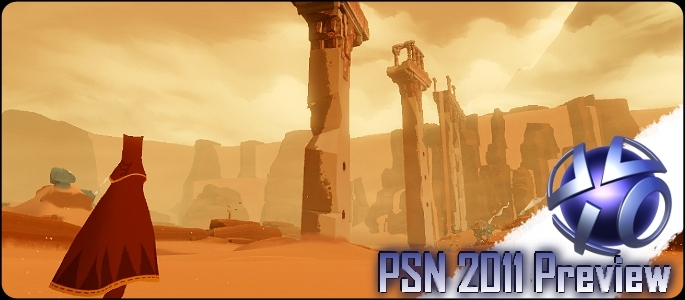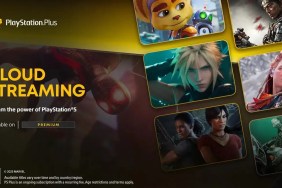thatgamecompany is back, after a long 2 year wait, with their next highly anticipated title Journey. The team behind the unique and tranquil worlds of flOw and Flower, have revealed only enough scraps of detail on their latest adventure to leave us begging for more. Journey puts you in control of a lone figure wandering throughout a vast desert, offering expansive visuals and beautiful landscapes that bring us back to that similar awe-inspired feeling experienced in the worlds of ICO and Shadow of the Colossus. Your character is on a quest to discover why they were in the desert in the first place, and what it is that is calling them instinctively towards the distant mountain. But more than a simple amnesia story, the team have been working to introduce a new style of gameplay that will attempt to reintroduce players to a sense of their own inner power, rather than relying on a traditional gaming theme of becoming almighty, and beyond human.
Their re-envisioning does not stop there, as the plans to incorporate multiplayer in the mix go beyond the traditional 1 player and 2 player co-op play. It’s a fresh, unique system where an online second player can seamlessly weave into your game in the midst of their own Journey. You can choose whether or not to travel with them, as multiplayer collaboration will not be forced, but by choosing to do so, you may learn new things about the barren desert. Given the setting, the multiplayer idea is to create an environment where players welcome interactions with others, rather than ignoring them.
If nothing else, Journey promises to be unique from everything else thatgamecompany has created, which is quite the feat when every one of their titles have been unlike any other game created.
To find out more about Journey, we spoke with Kellee Santiago, President and Co-Founder of thatgamecompany, as part of our PSN 2011 Preview Week coverage.
thatgamecompany’s games are unlike anything else on the market — what drives you to be so different?
Well, that’s a pretty big question! As gamers ourselves, Jenova and I were recognizing in our own play styles that the kinds of games that used to entertain us weren’t as engaging anymore. We no longer had time for 40+ hours of gameplay, but we wanted something more intellectually and emotionally stimulating than the typical casual game.
We also felt like there was a lot more to explored in terms of emotions in games. And we believe that there really isn’t such a thing as a “non-gamer,” they’re just people who haven’t played a game they’ve liked yet. So we founded thatgamecompany to create emotionally engaging, broadly accessible games that could reach what we saw as a vast, and yet untapped, audience.
Did you ever consider going with something more traditional?
Hm, in someways no, in other ways we don’t really think about our work like that. We begin each project with an emotion, or experience we want the player to have. For instance, for “Flower,” we wanted to give players the experience of being able to come home from their hectic lives and escape through their PS3 into a serene environment. We also wanted to give them a feeling of catharsis, which is how the inspiration for the narrative began.
When we’re driving towards that feeling, we don’t think about “let’s make sure not to do anything traditional.” The development team tries anything they believe will achieve that emotion, and we playtest, playtest, playtest. However, thatgamecompany’s mission is to make games that push the communicative boundaries of video games as a medium – so the emotion that is chosen for each project is deliberately chosen as something unique from most mainstream games.
Journey’s world has an overwhelming sense of wonder about it — it’s begging to be explored — was there ever a fear that its vastness might be intimidating?
That’s kind of the point of the world – to make the player feel small against the elements.
We akin Journey to the beginning of civilization, where man seeks to learn more about his origins, and why he’s there in the first place — how are these types of questions answered through the gameplay?
All the player knows when they wake up in Journey is that there is a mountain in the distance they are pointed towards. The experience of the game is discovering why you are on this journey, and what happened.
With that emptiness comes a feeling of loneliness – was that intentional in order to encourage players to work together?
It was intended to make the presence of another player special.
There aren’t any means of communication between players, no PSN IDs are displayed — is there any specific way players will be able to recognize one another?
Players have somewhat abstract symbols on their fronts, so they can recognize when they encounter someone different, and if the run into the same player again. But there’s no way of knowing who exactly you are playing with – just that it’s another human being.
You are never told where to go, yet you are drawn toward the goals almost instinctively – is it difficult to convey direction within the game without communication?
Yes. In each of our games we have discovered the simple/elegant solution is usually the most complicated. But we believe there are so many tools available to us now as game makers with surround sound and next-gen graphic that there’s no reason to rely on the HUD tropes of the past.
Both flOw and Flower were controlled using SIXAXIS motion sensing, will similar controls be implemented into Journey? Are there any plans to use PlayStation Move?
Accessibility is at the core of our design philosophy, and the SIXAXIS motion sensing allows us to create controls that are easier to use for a wide variety of people, so we will be using it again in Journey. Unfortunately, development on our Journey began before the Move, so we have designed it with only one control scheme in mind.
What are your goals with the penchant toward anonymity in terms of multiplayer?
We didn’t want to the player to be taken out of the experience of the game by the specifics of an individual, but instead just know that it’s another human being. In line with our goal to create accessible experiences, creating a space with no gamer tags or in-game messaging allows many players new to online gaming to feel safer, as well as parents and children.
Flower was such a lush and vibrant game. Why did you choose a desert location for Journey? Can you tell us a little bit about the sand effects?
In thinking about creating an experience to make a player feel small, a desert came about as a good setting – it’s such a harsh, unforgiving environment. We traveled as a team out to the Pismo Beach Dunes in California to get a feel for what it was like walking through sand, and a lot of the details in the sand effects came from that experience. The sand reacts to the player’s movement just as real sand would, but there are sections of the game where the sand takes on almost a liquid-like quality, creating waves on which the player can surf.
Do you think the success of your previous titles has strengthened publisher’s confidence in funding innovative and risky titles?
I hope so – I think the first year of digital distribution saw some great early successes, with “flOw,” “Braid,” and “World of Goo,” and I think that did open up more publishers and investors to the possibilities of downloadable games.
thatgamecompany, flOw – what is this love affair with lowercase letters?
Hah! I think it’s a love affair with simplicity.
Journey is the third title in a 3-game deal with Sony. Through this deal, thatgamecompany has become almost synonymous with creativity on the PlayStation 3. What does the future for thatgamecompany hold?
Right now we are really just focused on delivering “Journey” to the PSN audience. With only 12 people, that’s just how we roll!
We’d like to thank Kellee Santiago and thatgamecompany for taking time out of their busy production schedule to speak with us!
Interview conducted by Anthony Severino, preview written by Max Murray.








